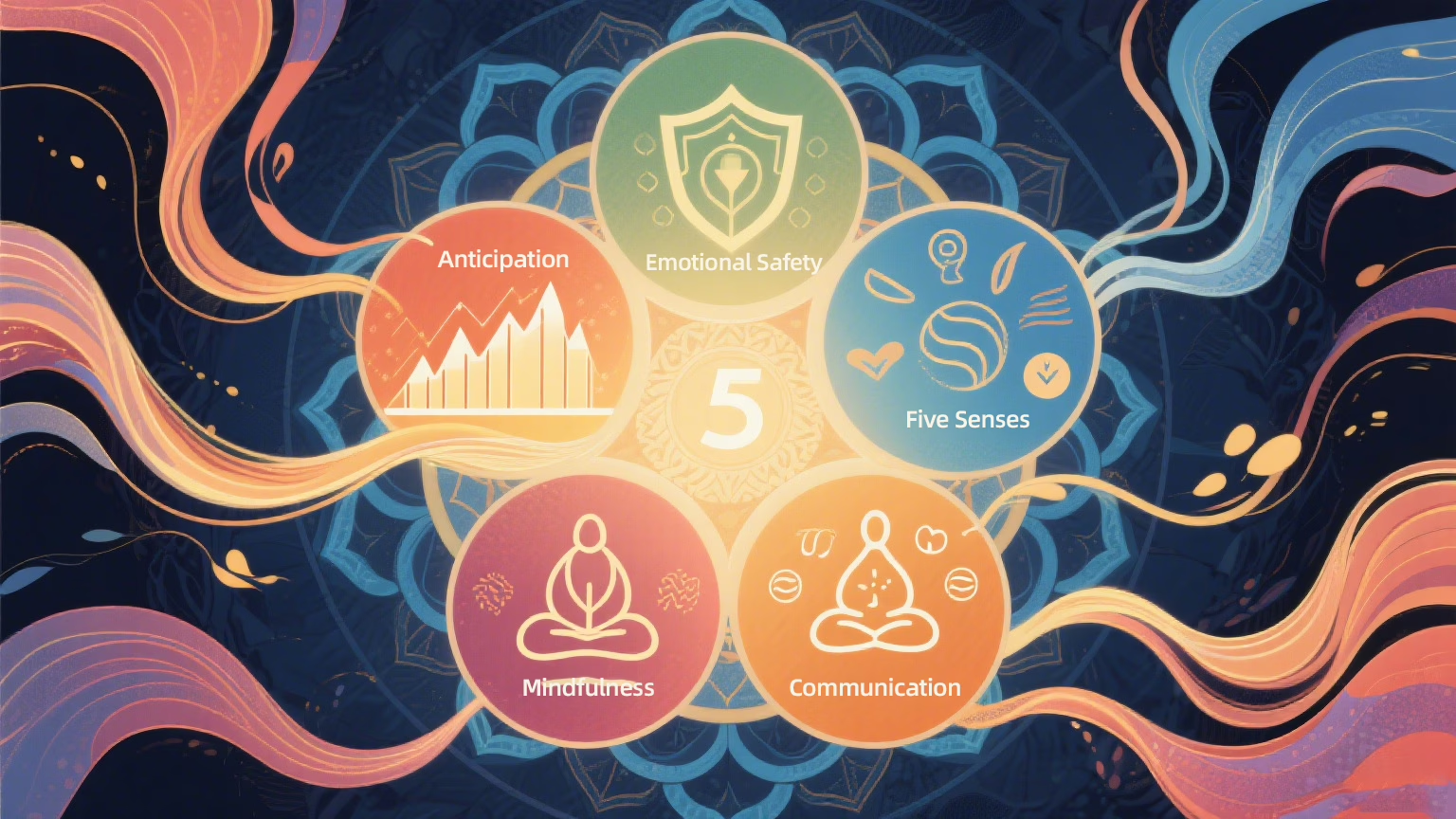Introduction
Foreplay isn’t just a prelude to intimacy—it’s an art form backed by decades of psychological research. While many couples view foreplay as a brief warm-up before the “main event,” science reveals that the mental and emotional aspects of intimate connection are far more complex and powerful than most people realize.
Understanding the psychology behind arousal, anticipation, and intimate connection can transform your relationship’s physical and emotional intimacy. By applying evidence-based psychological principles to your intimate moments, you can create deeper connections, more intense arousal, and more satisfying experiences for both partners.

The five psychology-backed techniques we’ll explore go beyond the physical mechanics of touch and sensation. They tap into fundamental aspects of human psychology: anticipation, emotional safety, sensory enhancement, mindfulness, and emotional intimacy. These approaches are supported by research in neuroscience, behavioral psychology, and human sexuality studies.
Whether you’re looking to reignite passion in a long-term relationship or deepen intimacy with a new partner, these scientifically-informed strategies will help you create more meaningful and exciting intimate experiences.
The Neuroscience of Arousal and Anticipation
Understanding the Arousal Process
Sexual arousal isn’t just physical—it’s a complex interplay between mind and body that begins long before any physical touch occurs. Research in neuroscience shows that sexual arousal involves multiple brain regions, including the limbic system (responsible for emotion and reward), the prefrontal cortex (involved in fantasy and anticipation), and various sensory processing areas.
Dr. Barry Komisaruk’s groundbreaking research using fMRI brain imaging revealed that sexual arousal activates the same reward pathways as other pleasurable experiences like eating delicious food or listening to beautiful music. However, sexual arousal is unique in its ability to create sustained anticipation and build intensity over time.

The Psychology of Anticipation
Anticipation is one of the most powerful psychological tools for enhancing sexual experiences. The brain’s dopamine system, which drives motivation and reward-seeking behavior, is actually more active during anticipation than during the actual reward itself. This means that building anticipation can be more exciting than the climactic moments themselves.
Studies show that when we anticipate pleasure, our brains release dopamine, creating feelings of excitement and motivation. This neurochemical response can be prolonged and intensified through psychological techniques that build suspense and delay gratification.
Tip #1: Master the Art of Mental Foreplay Through Anticipation Building
The Science Behind Mental Arousal
Mental foreplay begins hours or even days before physical intimacy. Research published in the Archives of Sexual Behavior demonstrates that individuals who engage in anticipatory thinking about sexual encounters report significantly higher levels of arousal and satisfaction during actual intimate moments.
The key is understanding that the brain is our most powerful sexual organ. By engaging your partner’s imagination and building anticipation throughout the day, you’re essentially priming their nervous system for heightened arousal and deeper connection.
Practical Application: The 24-Hour Anticipation Strategy
Morning Messages: Start building anticipation early in the day with subtle, suggestive messages that hint at evening plans without being explicit. The goal is to plant seeds of anticipation that will grow throughout the day.
Sensory Previews: Leave subtle sensory cues that remind your partner of intimate moments you’ve shared or hint at what’s to come. This might be a particular cologne or perfume, a specific playlist, or even a meaningful object left in a strategic location.
Progressive Revelation: Throughout the day, gradually reveal more details about your evening intentions. This progressive disclosure keeps the anticipation building rather than reaching a peak too early.

The Psychological Impact
This technique works because it engages what psychologists call “positive anticipatory stress.” Unlike negative stress, this type of anticipation activates the sympathetic nervous system in ways that enhance rather than inhibit sexual response. The sustained dopamine release throughout the day creates a state of heightened sensitivity and awareness that transforms ordinary touch into intense sensation.
Tip #2: Create Emotional Safety Through Vulnerability and Trust Building
The Psychology of Emotional Safety in Intimacy
Dr. Sue Johnson’s research on adult attachment and intimate relationships reveals that emotional safety is the foundation of passionate physical connection. When partners feel emotionally secure, their bodies can fully relax into arousal and pleasure. Conversely, any underlying anxiety or emotional tension creates physiological barriers to full sexual response.
Creating emotional safety isn’t just about avoiding conflict—it’s about actively building trust, demonstrating care, and creating space for vulnerability. This emotional foundation allows both partners to be fully present and responsive during intimate moments.
Practical Application: The Emotional Check-In Protocol
Pre-Intimacy Connection Ritual: Before any physical touch, spend 5-10 minutes in focused conversation about your day, feelings, or experiences. This doesn’t mean discussing problems or conflicts, but rather sharing genuine moments of connection that reinforce your emotional bond.
Verbal Appreciation: Express specific appreciation for your partner before beginning physical intimacy. Research shows that feeling valued and appreciated creates physiological changes that enhance sexual response, including increased blood flow and hormone production.
Permission and Consent Dialogue: Make consent an ongoing, enthusiastic conversation rather than a one-time check. This might sound like “What feels good for you right now?” or “How do you want to be touched?” This ongoing dialogue builds trust and ensures both partners feel heard and respected.

The Neurological Benefits
When emotional safety is established, the nervous system shifts from a state of vigilance to receptivity. This physiological change increases sensitivity to pleasurable sensations, enhances the body’s natural lubrication and arousal responses, and allows for deeper states of pleasure and connection.
Tip #3: Engage All Five Senses for Complete Arousal Activation
The Multisensory Nature of Sexual Arousal
Human sexuality involves all five senses, yet many couples rely primarily on visual and tactile stimulation. Research in sensory psychology shows that engaging multiple senses simultaneously creates more intense and memorable experiences because it activates broader networks in the brain.
Each sense contributes uniquely to arousal: visual stimulation activates the brain’s reward centers, auditory input can trigger emotional memories and responses, scent directly influences the limbic system and hormone production, taste creates intimate connection and trust, and touch obviously provides direct physical pleasure.
Practical Application: The Five-Sense Foreplay Sequence
Visual Enhancement: Create visual interest through lighting, lingerie, or environmental changes that signal transition from ordinary life to intimate time. The key is novelty and intentionality rather than perfection.
Auditory Stimulation: Use music, whispered words, or even specific vocal tones to create auditory pleasure. Research shows that lower-pitched voices are perceived as more sexually attractive and can enhance arousal responses.
Olfactory Engagement: Engage the sense of smell through natural body scents, subtle perfumes, or environmental scents like candles or essential oils. The olfactory system has direct connections to memory and emotion centers in the brain.
Taste Incorporation: Include taste through kissing, shared drinks, or foods that you feed each other. The act of sharing taste creates psychological intimacy and triggers bonding hormones.
Tactical Variation: Use different types of touch—light caresses, firm pressure, temperature variations, and different textures—to keep the nervous system engaged and responsive.

The Psychological Advantage
Multisensory experiences create what psychologists call “embodied cognition”—a state where the mind and body are fully integrated and responsive. This integration allows for more intense experiences and creates stronger memory formation, making intimate moments more satisfying and memorable for both partners.
Tip #4: Practice Mindful Presence to Intensify Every Sensation
The Science of Mindfulness in Sexual Experience
Research published in the Journal of Sex Research shows that mindfulness practices significantly improve sexual function, arousal, and satisfaction. Mindfulness—the practice of present-moment awareness without judgment—allows individuals to fully experience sensations without distraction from performance anxiety, daily worries, or self-consciousness.
Dr. Lori Brotto’s extensive research on mindfulness and sexuality reveals that even brief mindfulness practices can improve sexual response by increasing body awareness, reducing anxiety, and enhancing the ability to focus on pleasurable sensations.
Practical Application: The Mindful Touch Protocol
Breath Synchronization: Begin intimate moments by synchronizing breathing with your partner. This simple practice activates the parasympathetic nervous system and creates immediate emotional and physical connection.
Slow Motion Exploration: Deliberately slow down all movements and touches. Research shows that slower touch is perceived as more sensual and creates more intense neurological responses than rushed contact.
Present-Moment Narration: Verbally share what you’re experiencing in the moment—how something feels, what you notice about your partner, or what sensations you’re aware of. This practice keeps both partners anchored in the present experience.
Mindful Pausing: Deliberately pause during intimate moments to simply experience and savor sensations. These pauses allow arousal to build naturally and prevent the rush toward climax that can reduce overall satisfaction.

The Neurological Benefits
Mindfulness practice increases activity in the prefrontal cortex while decreasing activity in the amygdala (the brain’s alarm center). This neurological shift allows for greater sensitivity to pleasure while reducing anxiety and distraction. Additionally, mindful attention increases the release of oxytocin, the bonding hormone that enhances emotional connection during intimate moments.
Tip #5: Build Emotional Intimacy Through Vulnerable Communication
The Psychology of Vulnerability in Sexual Connection
Dr. Brené Brown’s research on vulnerability reveals that emotional courage and openness are essential for deep connection and authentic intimacy. In sexual relationships, the willingness to be vulnerable—to share desires, fears, and experiences—creates the trust necessary for both partners to fully surrender to pleasure and connection.
Sexual vulnerability isn’t just about sharing fantasies or desires; it’s about creating emotional transparency that allows both partners to feel seen, accepted, and valued for their authentic selves. This emotional intimacy directly enhances physical intimacy by removing barriers to full arousal and response.
Practical Application: The Intimate Communication Framework
Desire Sharing Ritual: Create regular opportunities to share sexual desires, fantasies, or curiosities without judgment or pressure to act on them immediately. The goal is creating emotional intimacy through honest sharing.
Appreciation Specificity: Express specific appreciation for your partner’s body, responses, or actions during intimate moments. Specific appreciation (“I love how you respond when I touch you here”) is more psychologically impactful than general compliments.
Emotional State Sharing: Share your emotional state during intimate moments—excitement, nervousness, joy, or any other feelings. This emotional transparency creates deeper connection and helps partners respond to each other’s needs.
Feedback Without Criticism: Create space for gentle feedback about preferences, desires, or suggestions without making your partner feel criticized or inadequate. Frame feedback in terms of your own desires rather than their performance.

The Psychological Impact
Vulnerable communication triggers the release of oxytocin and builds what researchers call “earned security”—the sense that this relationship is a safe space for authenticity. This psychological safety allows both partners to experience arousal without self-consciousness or performance anxiety, leading to more intense and satisfying intimate experiences.
The Compound Effect: Combining All Five Techniques
Synergistic Psychology
While each technique is powerful individually, combining them creates what psychologists call a “synergistic effect”—the whole becomes greater than the sum of its parts. When anticipation building, emotional safety, multisensory engagement, mindfulness, and vulnerable communication work together, they create optimal conditions for both physical and emotional intimacy.
Research in relationship psychology shows that couples who consistently apply multiple intimacy-enhancing techniques report higher relationship satisfaction, better sexual function, and stronger emotional bonds over time.
Creating Your Personal Protocol
Weekly Anticipation Planning: Set aside time each week to plan how you’ll build anticipation for intimate moments. This might involve scheduling date nights, planning surprises, or simply discussing desires and fantasies.
Daily Connection Rituals: Establish small daily practices that reinforce emotional safety and connection—morning appreciation, evening check-ins, or brief mindfulness moments together.
Sensory Environment Preparation: Create consistent rituals around preparing your intimate environment to engage all five senses. This preparation becomes part of the anticipation and helps signal the transition to intimate time.

Advanced Psychological Techniques
The Psychology of Novelty and Surprise
Human brains are wired to respond strongly to novelty and surprise. In intimate relationships, this translates to the importance of varying routines, trying new experiences, and maintaining an element of unpredictability. Research shows that couples who regularly introduce novelty into their intimate lives maintain higher levels of passion and satisfaction over time.
Novelty Implementation: Regularly change locations, timing, approaches, or activities to keep the brain’s reward systems engaged. The key is not dramatic changes but consistent small variations that prevent habituation.
Surprise Elements: Incorporate unexpected elements into intimate moments—a surprise touch, an unexpected location, or a novel sensory experience. The element of surprise activates the same neural pathways as falling in love.
The Role of Emotional Attunement
Emotional attunement—the ability to sense and respond to your partner’s emotional and physical state—is crucial for optimal intimate connection. This skill can be developed through practice and attention to subtle cues like breathing patterns, muscle tension, vocal tones, and facial expressions.
Attunement Practice: During intimate moments, focus on reading your partner’s responses and adjusting your approach accordingly. This responsiveness creates a feedback loop that enhances pleasure for both partners.
Non-Verbal Communication: Develop sensitivity to non-verbal cues that indicate arousal, comfort, or desire for change. This skill allows for seamless adjustment and responsiveness during intimate moments.
Common Psychological Barriers to Great Foreplay
Performance Anxiety and Self-Consciousness
Many individuals struggle with performance anxiety or self-consciousness that prevents them from fully enjoying intimate moments. These psychological barriers create physical tension that interferes with arousal and pleasure.
Solutions: Focus on pleasure rather than performance, practice self-compassion, and communicate openly about anxieties with your partner. Remember that great intimacy is about connection and pleasure, not performance metrics.
Routine and Habituation
Long-term relationships often fall into predictable patterns that can reduce excitement and anticipation. The brain’s tendency to habituate to familiar experiences can diminish the intensity of intimate moments over time.
Solutions: Regularly introduce novelty, vary routines, and approach familiar activities with fresh curiosity and attention. Treat each intimate encounter as a new opportunity for discovery and connection.

Long-Term Benefits of Psychology-Based Foreplay
Relationship Satisfaction and Bonding
Couples who consistently apply psychological principles to their intimate lives report higher overall relationship satisfaction, stronger emotional bonds, and greater resilience during difficult periods. The trust, communication, and emotional intimacy developed through mindful intimate practices strengthen all aspects of the relationship.
Individual Psychological Benefits
Regular practice of these techniques also provides individual psychological benefits including reduced stress and anxiety, improved body image and self-confidence, enhanced emotional regulation, and increased overall life satisfaction.
Sexual Health and Function
From a sexual health perspective, psychology-based approaches to intimacy often improve sexual function, increase satisfaction, and help prevent or address common sexual difficulties. The reduced performance pressure and increased present-moment awareness allow the body’s natural responses to function optimally.
Adapting Techniques for Different Relationship Stages
New Relationships
In newer relationships, focus more heavily on emotional safety building and communication techniques. The anticipation element may happen naturally due to novelty, but establishing trust and emotional intimacy is crucial for long-term success.
Established Relationships
Long-term couples may need to focus more on novelty introduction and anticipation building, as emotional safety and communication patterns are already established. The challenge is preventing habituation and maintaining excitement over time.
Relationships in Transition
Couples going through major life changes or difficulties may need to emphasize emotional safety and mindfulness techniques while temporarily reducing pressure for novelty or intense physical connection.
Conclusion
The psychology behind great foreplay goes far deeper than physical technique or timing. By understanding and applying principles from neuroscience, behavioral psychology, and relationship research, couples can create intimate experiences that are not only more pleasurable but also more emotionally connecting and relationship-strengthening.
The five techniques outlined—anticipation building, emotional safety creation, multisensory engagement, mindful presence, and vulnerable communication—work together to optimize the psychological and physiological conditions for intimate connection. These aren’t just techniques for better sex; they’re tools for building deeper, more satisfying relationships overall.
Remember that implementing these approaches takes time, practice, and patience. Start with the techniques that feel most natural or appealing to you and your partner, and gradually incorporate others as you become more comfortable with the psychological aspects of intimacy.
Most importantly, approach these practices with curiosity, playfulness, and compassion for yourself and your partner. Great intimacy isn’t about perfection—it’s about authentic connection, mutual pleasure, and the ongoing journey of discovering each other more deeply.
The investment in understanding and applying the psychology of intimate connection pays dividends not just in your intimate life, but in the overall quality, satisfaction, and resilience of your relationship. Your future self—and your partner—will thank you for the time and attention you invest in creating more meaningful, exciting, and deeply satisfying intimate experiences.


